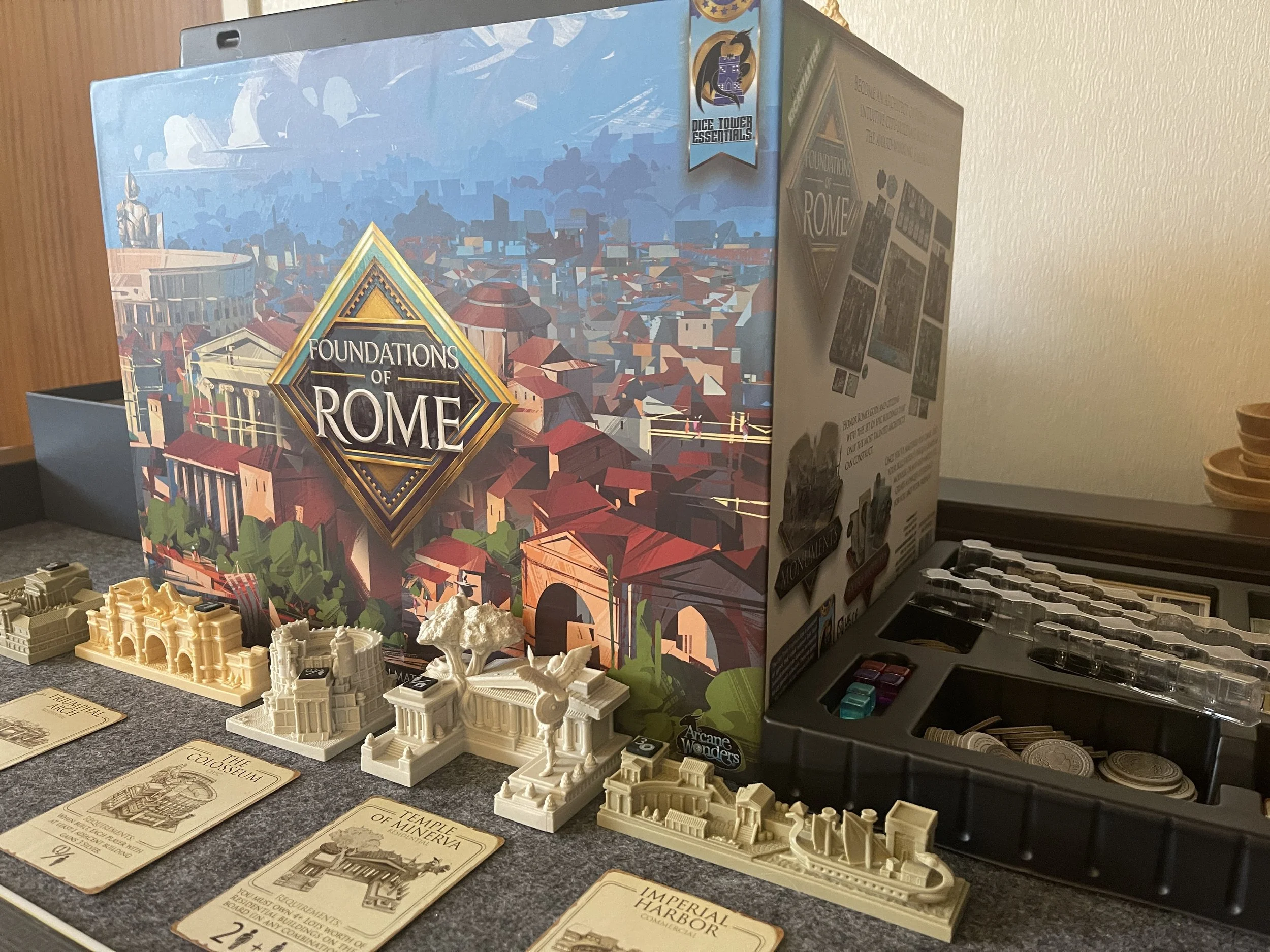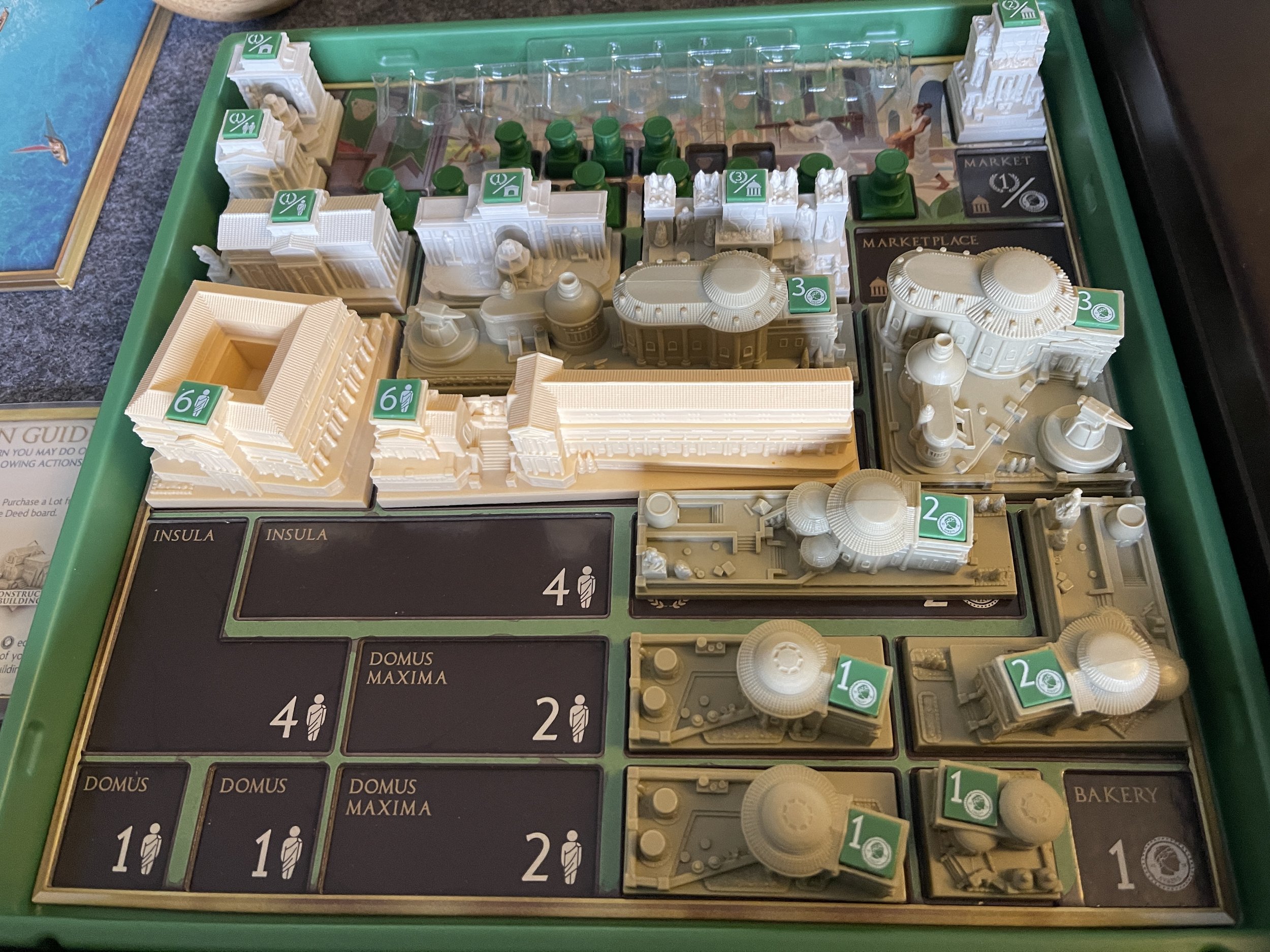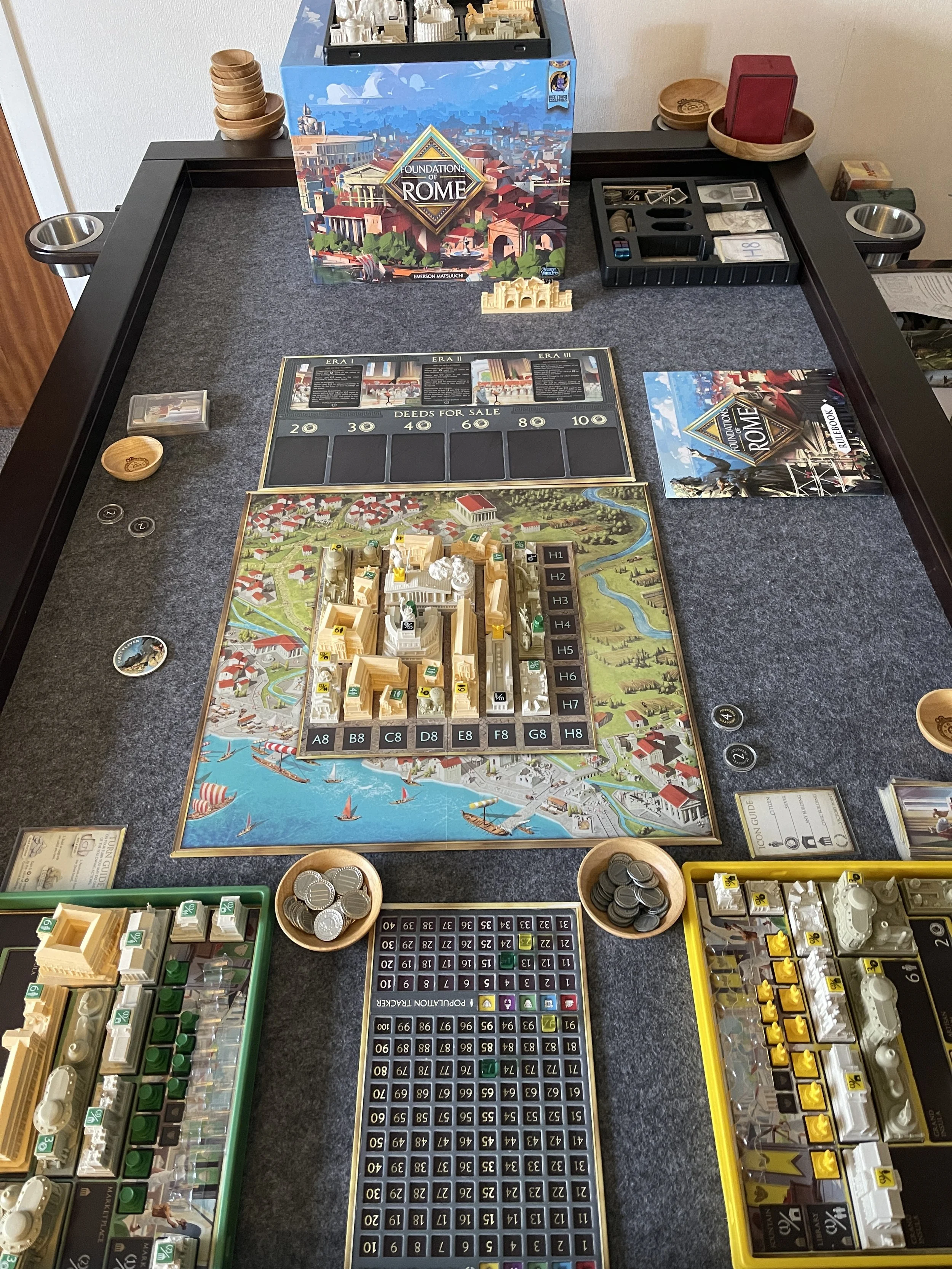Foundations of Rome Review
They say all roads lead to Rome, just make sure there’s something for folks to see when they get there.
2-4 (1-5) Players 60-90 Min Age: 13+
Designer: Emerson Matsuuchi
Artists: Stephen Gibson, Damien Mammoliti
Publisher: Arcane Wonders
Are You Ready To Do Your Duty For Rome?
Foundations of Rome is a 2-4 player game from Arcane Wonders in which you play architects tasked with expanding the glory of Rome by building infrastructure, monuments and civil buildings to grow the city into the burgeoning metropolis history remembers. Players achieve this by purchasing lots from a competitive market and ensuring they have acquired the right locations to build the structures they need.
Foundations of Rome involves elements of area control, tile laying and hand management. And while it’s a sprawling game packaged in a coliseum-sized box, the game its is grounded in a light, approachable rule set and plays quickly even at higher player counts.
Players compete with each other to construct the most grand and valuable areas of the city, this can be done several ways, but the most obvious is by buying up and locking others out of certain areas or leaving them unable to fit certain monuments or constructions, while ensuring the yours are well positioned. On their turns, players each have the option to purchase a lot, construct a building, or receive income. The game board is depicted by an alphanumeric grid representing properties and expands to accommodate more players. A player may purchase a single card from the market row each of which depicts the co-ordinate of the lot, for example, B3, and then place a lot marker on that space. The player now owns that space and no one else can build there.
Buildings come in varying shaped polyominoes (think TETRIS pieces) which players then try to fit together most beneficially. Some buildings will increase the players’ income, others will increase their population and thereby their score, and others, such as civic buildings score based on the other buildings around them, and not necessarily limited to those owned by their player. All these elements come together in an extremely satisfying package. Seeing the city gradually expand is as rewarding as securing that one property you’ve had your eye on for the last three turns that have now dropped in price to be purchased at a bargain.
The game ends when the last space has been purchased. Everyone gets one final turn and then moves into final scoring to see who has contributed the most to the greatness of Rome. Points are scored based on the type, size and number of buildings as well as positioning and their relationship to other buildings in the area. Additionally, players have objectives which can contribute to their scores and often inform their decision-making throughout the game.
Strength And Honour
So, why play Foundations of Rome? To begin with, it’s a lightweight game with an easygoing ruleset that keeps the focus on gameplay, which, in turn, is relatively quick-paced, aside from the occasional bout of analysis paralysis. Each turn feels rewarding even if you don’t end up building something while the wider game remains strategic as players start to out-think and out-manoeuvre one another, especially as space becomes a premium.
At first glance, Foundations of Rome appears intimidating, from the massive box, and plastic trays filled with dozens of buildings to the large double-sided board everything about this production suggests it’s a far heavier game than it is. I was able to teach this to our group in a matter of minutes and they had the basics in pace after the first round. By the end of our first game, the usual questions had ceased completely and all players appeared confident. The game remains true to its proposed play time, clocking in at between 40-60 minutes for most 2-3 players games, once everyone has a handle of the basics.
Depending on the version you end up getting, there are options to expand the game in a modular fashion. The version I have supports an expanded player count from 1-5 players and adds the Monuments expansion that allows players to compete to build several noteworthy historical structures, such as Circus Maximus. Yet another module provides a cooperative mode in which the players work together to fulfil the designs of the Emperor and create his ideal layout for this grand city. Most of these expansions can be played alongside one another or just plugged in individually for a variant experience. Whichever you choose, Foundations of Rome’s modules add depth and variability to an already fully fleshed-out gameplay experience.
Are You Not Entertained?
While the game is a gorgeous beast to behold, it comes at a price. For many players, the option of a purely tile-based experience would provide the same core gameplay as the highly detailed miniatures version, albeit, not as eye-catching. I love miniatures, I love deluxe games and I love Foundations of Rome for all that it provides for a gamer such as myself, but even I can admit that the game is overproduced. For me, that’s not a problem it is what caught my eye in the first place, but for many, it will be difficult to justify the cost, both in money and shelf space for what is, for the most part, a light to medium weight tile laying game.
Not only that but at higher player counts, this game is going to require some serious real estate. so bear that in mind if you have limited table space. 1-3 players should manage on most decent-sized tables but 4-5 is going to push most gaming tables to their limit.
Conjure Magic For Them And They’ll Be Distracted
So what can you expect if you do decide to take the plunge? In short, an absolutely top-class production. Beautifully detailed buildings bring your cities to life with more than a few familiar structures. You’ll find yourself picking them up to admire them during gameplay, and once your group has their city underway, it’s exciting to see it grow and flourish, to the point where, no matter who wins, everyone at the table walks away with a sense of accomplishment, having contributed to beautiful city-scape.
The excellent storage solution in the form of moulded trays accommodates fast setup and tear down as well as remaining functional throughout gameplay. You’ll be pleased to know that each tray comes with its own form-fitting lid, so there’ll be no concerns about opening the box and seeing a natural disaster area in place of a city.
Could the game have cut costs and used cardboard tiles in place of miniatures? Of course, but then I likely wouldn’t have paid it as much attention not to mention the visual satisfaction that the premium embellishments provide. Those who value their wallets or are simply content to have a more down-to-earth production may want to hold out for Foundations of Metropolis, set to release this year. The game provides the same core experience as its Roman counterpart but uses polyomino tiles in place of miniatures. That game will also be set in what appears to be a contemporary setting, so unless the theme of Rome is vital to your experience, Metropolis could be what you’re after.
Shadows And Dust
Foundations of Rome is a well-crafted city-building game with a theme I enjoy. Seeing the ancient city brought to life on my table always brings a smile to my face and I can tell this is one of my never-sells, it’s earned a permanent place in my collection, despite the space it takes up on my shelves. The game’s low rule overhead belies its deeper strategic underpinnings, but not to the point that it alienates new players. Whether you prefer to play solo or with friends, you’re sure to find Foundations of Rome a deeply rewarding experience.
Thanks for joining me again for another review, I hope you were entertained. Does Foundations of Rome sound like you’re kind of game? Why not share your own thoughts in the comments below or head over to our Above Board Facebook group to join our growing community of like-minded gamers? Hope to see you there. Oh, and we’re also on Instagram now, because photos of pretty games are cool!











